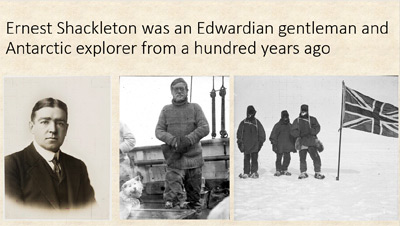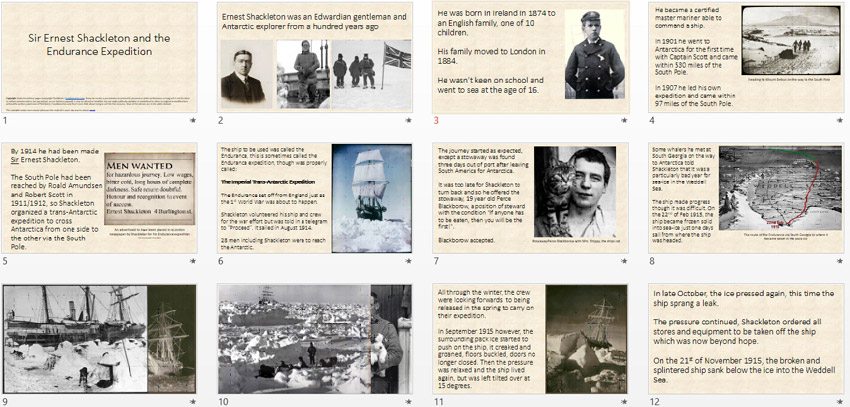Ernest Shackleton Power Point Presentation
The Endurance
Expedition
Ages 11 - 16. A presentation
for use in schools by teachers and students or anyone interested
in the story of Ernest Shackleton and his 1914-1917 Imperial
Trans-Antarctic Expedition. Fully illustrated by Frank Hurley's
pictures with a concise accompanying narrative.
geography, history, English
 Ernest
Shackleton and the voyage of the Endurance - click to open or
download
Ernest
Shackleton and the voyage of the Endurance - click to open or
download
10.5Mb - 27 slides - Suitable for ages from
11 upwards
Alternate file types, open or download:
as a .pdf
as
an .mp4
Pictures only: as a Word file | as a pdf
Copyright: Material on these pages is copyright Paul Ward / CoolAntarctica.com. It may be used as a presentation or printed for personal or public performance as long as it is not for direct or indirect commercial use (no pay to view, no use behind a paywall). It may be altered or modified, but not made publically available or transmitted to others in original or modified form without the written permission of Paul Ward / CoolAntarctica.com. Don't even think about trying to sell this free resource. Most of the pictures are in the public domain.
Sample slides

Accompanying Text
1 - Sir Ernest Shackleton and the Endurance
Expedition.
2 - Ernest Shackleton
was an Edwardian gentleman and Antarctic explorer from a
hundred years ago.
3 - He was born
in Ireland in 1874 to an English family, one of 10 children.
His family moved to London in 1884.
He wasn't
keen on school and went to sea at the age of 16.
4 - He became a certified master mariner
able to command a ship.
In 1901 he went to Antarctica
for the first time with Captain Scott and came within 530
miles of the South Pole.
In 1907 he led his own expedition
and came within 97 miles of the South Pole.
5 - By 1914 he had been made Sir Ernest
Shackleton.
The South Pole had been reached by Roald
Amundsen and Robert Scott in 1911/1912, so Shackleton organized
a trans-Antarctic expedition to cross Antarctica from one
side to the other via the South Pole.
6 -
The ship to be used was called the Endurance, this is sometimes
called the Endurance expedition, though was properly called:
The Imperial Trans-Antarctic Expedition
The Endurance
set off from England just as the 1st World War was about
to happen.
Shackleton volunteered his ship and crew
for the war effort but was told in a telegram to "Proceed"
. It sailed in August 1914.
28 men including Shackleton
were to reach the Antarctic.
7 -
The journey started as expected, except a stowaway was found
three days out of port after leaving South America for Antarctica.
It was too late for Shackleton to turn back and so he
offered the stowaway, 19 year old Perce Blackborow, a position
of steward with the condition "If anyone has to be eaten,
then you will be the first!".
Blackborow accepted.
8 - Some whalers he met at South Georgia
on the way to Antarctica told Shackleton that it was a particularly
bad year for sea-ice in the Weddell Sea.
The ship
made progress though it was difficult. On the 22nd of Feb
1915, the ship became frozen solid into sea-ice just one
days sail from where the ship was headed.
9 - The ship drifted with the sea-ice north-wards,
away from where they wanted to go.
The crew lived
on the ship through the winter, it was bitterly cold,
there were 24 hours darkness around midwinter, the 21st
of June.
The sled dogs were put onto the sea-ice
where they lived in "dogloos", small igloos made of compacted
snow.
10 - The dogs had been brought
from England on the Endurance, some pups were born on the
journey south, they would join the sled teams when they
were big and strong enough.
Trips by dog sled were
popular in the quiet winter months when there was little
else to do, as well as being a requirement to exercise the
dogs and allow the men to practice their dog sled driving
skills.
11 - All through the winter,
the crew were looking forwards to being released in
the spring to carry on their expedition.
In September
1915 however, the surrounding pack ice started to push on
the ship, it creaked and groaned, floors buckled, doors
no longer closed. Then the pressure was relaxed and the
ship lived again, but was left tilted over at 15 degrees.
12 - In late October, the ice pressed
again, this time the ship sprang a leak.
The pressure
continued, Shackleton ordered all stores and equipment to
be taken off the ship which was now beyond hope. This first
place off the ship became known as "Dump Camp" because
of the amount of gear that was thrown away there.
"Ocean Camp" was established a mile and half from
the Endurance on more solid older ice.
On the 21st
of November 1915, the broken and splintered ship sank below
the ice into the Weddell Sea.
13 -
Pictures only.
14 - The
crew now were living at "Ocean Camp" .
There was
no radio, no-one in the outside world knew what had happened,
no rescue was going to come. They were on their own.
15 - The ice was still drifting north,
so they stayed at Ocean Camp for a month.
On the
23rd of December Shackleton decided to start to move Westwards
towards Paulet Island where he knew there was a substantial
food depot, the camp was abandoned and the crew and dogs
started to drag sleds and three lifeboats from the
Endurance across the sea-ice. A reconnaissance by dog sled
had shown the ice to be flat and suitable for travelling
as far as the eye could see.
16 -
After only a week un-negotiable broken and ridged ice to
5m high was encountered, a new camp is established "Patience
Camp", they were to live there on the floe for nearly three
and a half months.
On the 9th of April 1916 the ice
around had broken and the floe was surrounded by water.
It was time to take to the boats and head towards the
South Shetland Islands.
17 - For
five days, the men rowed and sailed the boats across the
sea dotted with ice-bergs and pack-ice.
For some
of them this was the hardest part of the journey, wet and
cold all the time, virtually no food or drinking water,
little sleep and many cases of frost bite.
At times
they had to bail the boats out to prevent the stormy sea
from sinking them and row for their lives.
18 - Eventually they arrived on Elephant
Island, ecstatic to be on land again after 497 days.
They spent a whole day drinking water from melted snow
and eating fresh seal meat until they all finally had enough,
the cooks worked hard!
A shelter was made from two
lifeboats and a low wall of stones and any other materials
they had with them. They called it the "snuggery" .
19 - Elephant island was a respite,
but the world wasn't going to come there. The outside world
didn't even know there was any problem with the expedition.
Shackleton decided to go back to South Georgia for rescue,
it was 800 miles away, one of the stormiest times of the
year and he only had an open boat that wasn't in the best
condition.
The 22 foot lifeboat James Caird set off
on the 24th of April, with a crew of 6, the next day the
pack-ice closed in again.
20 - The
voyage of the James Caird is one of the most epic small
boat journeys of all time.
Navigation was by "dead
reckoning" as the sun was covered by cloud for days
on end.
Ice up to 15 inches (38cm) thick formed on
the boat and threatened to capsize her, it had to be chipped
off by hands stiff with cold with the threat of frost bite.
Sea-water came in and made everything wet, gigantic
waves and storms made the men think they would never survive.
After 14 days though, they landed on South Georgia,
they had thought it might take them twice as long.
21 - South Georgia meant rescue was
nearby, but first Shackleton had to alert the whaling station.
They had landed on the wrong side of the island. To reach
the whaling station 22 miles away, the backbone of mountains
and glaciers that ran the length of the island had to be
crossed, no one had ever done this.
Shackleton set
off with Tom Crean and Frank Worsley to cross the mountainous
island. Two of the other men were unable to walk, the third
was left to look after them.
22 -
Once again with all the odds against them, Shackleton and
his two companions succeeded. They reached the whaling station
filthy and with torn clothes, unrecognisable at first.
"When we got to the whaling station, it was the thought
of all those comrades that made us so mad with joy... We
didn't so much feel safe as that they would be saved." Shackleton
in his diary
23 - Shackleton immediately
arranged for a British whale catcher to go from South Georgia
to Elephant Island and rescue the 22 men still there.
It was turned back by pack ice 60 miles away. Shackleton
went to find another rescue ship.
He tried a second
time and a third time, always being turned back by heavy
pack ice that the boats could not penetrate.
Eventually
a steam tug named Yelcho loaned by the Chilean government
made it through on the fourth attempt.
24
- Life on Elephant Island had been tough for the
remaining men, they thought rescue might come in a month,
it had been four months, food was short, some were ill and
getting worse, living conditions were very bad and it was
winter again.
25 - A boat from the
Yelcho soon approached close enough for Shackleton, who
was standing on the bow, to shout to Frank Wild:
"Are you all well?"
Wild replied:
"All safe,
all well!"
and the Boss replied:
"Thank God!"
26 - Not a single life was lost.
27 - The pictures in this presentation
were taken by Frank Hurley, the expedition photographer.
They were taken mainly on glass negatives with a large,
heavy, wooden box camera. They were rescued from the Endurance
as she was sinking, dragged across the sea-ice for 4 months,
taken in the lifeboats to Elephant Island and eventually
brought home by the Yelcho.
